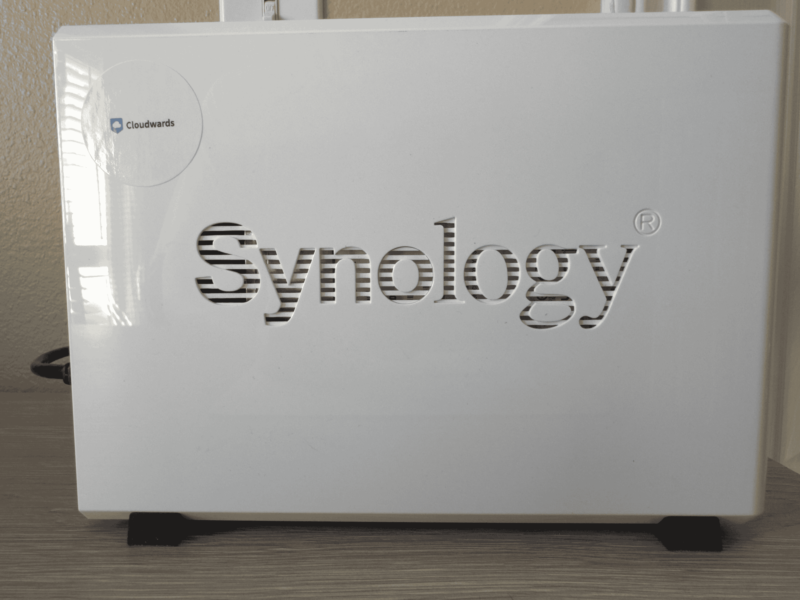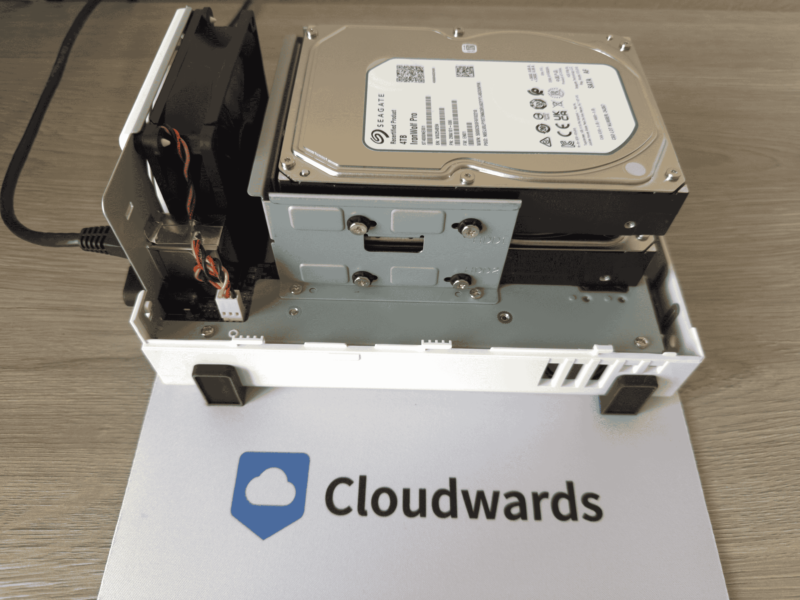NAS Security Guide: 7 Basic Principles for Synology & Other Devices in 2025
NAS devices are a great way to keep your data local and reduce the risk associated with third-party providers. However, NAS is not immune to digital threats. Read on to see how you can increase NAS security.
Network-attached storage (NAS) is a way to store data locally on a device connected to your local network, which differs from using the best cloud storage. A NAS device has an operating system and can handle several hard drives, giving the owner plenty of space and scalability to transfer data. However, don’t overlook NAS security against digital threats.
NAS systems are common in both home and business settings. When connected to a network, NAS devices are accessible by anyone on that network. For businesses, this makes a NAS a great alternative to paying for a third-party cloud-based subscription for storage and sharing needs.
If you decide to go with a NAS, you’ll need to buy the hardware and set it up with your home network. You might not be done yet even once it’s up and running, though — especially from a security perspective. Fortunately, we’ve got you covered. Read on to see the steps you need to take to keep your NAS secure.
-
11/22/2024 Facts checked
This article has been rewritten to show updated information on the best methods to protect your NAS.
What Is Network Attached Storage Security?
Network-attached storage security is the steps you take to keep both your NAS and the data it stores protected and safe. NAS is considered an inherently safe way to store your data. It is local and relies on your network to transfer data. When thinking of NAS security, your network plays a major role.
Beyond keeping our networks secure, NAS devices have built-in tools and features that can enhance their security. However, if you don’t take advantage of them, you risk a security vulnerability impacting your network-attached storage.

NAS Security Vulnerabilities
Despite seeming to be isolated from common cybersecurity threats, your NAS could have some vulnerabilities you might not be aware of. The good news is that many of the vulnerabilities are easily correctable, so you can keep your NAS protected without too much hassle. Some general NAS security vulnerabilities include:
- Misconfiguration: Misconfiguration happens when you fail to set up hardware, software, networks or systems. These are often classified as mistakes or errors. For a NAS device, misconfiguration can happen during the initial setup with your system, while connecting to your network or when configuring settings within the NAS.
- Outdated protocols: You may be using outdated protocols, especially those related to TLS/SSL encryption. Outdated protocols can introduce a vulnerability during data transfer, even between your computer and NAS.
- Insecure user management: A NAS is like any other device on a network. When one or more people have too many unnecessary privileges, it can lead to vulnerabilities. In worst-case scenarios, too many privileges can lead to compromises across the entire network.
- Weak passwords: Weak passwords continue to be the easiest and most exploitable way into a network or system. This includes NAS devices. Like other devices, NAS devices come with default usernames and passwords. If you don’t change the passwords, a NAS device becomes an easy target.
- Malware and targeted cyberattacks: Because a NAS device may not be directly connected to the internet, data transferred to and from it may not reach the wider global network. However, that does not mean NAS devices are immune to malware or cyberattacks.
- Command injection attacks: A command injection lets attackers execute commands on the OS of a device. Since NAS devices have an OS and can accept commands from terminals or PowerShell, this security vulnerability must be considered.

NAS Security Guide: Best Practices
A NAS is an excellent addition to any network, whether at home or at work. Fortunately, you can take several steps and implement some best practices to keep your NAS — and the data it holds — protected from security vulnerabilities. As is often the case with the internet and your accounts, protecting your NAS starts with a strong password.
1. Implement Strong Password Security
Weak and easily guessed passwords remain the top cybersecurity vulnerability, and this certainly applies to many NAS systems. It is almost impossible to overstate how important it is not only to change the default password on your NAS device but also to choose one that is hard to guess. The same may apply to the username.
Since NAS devices come with an OS, they have a network address or even a graphical user interface you can use to change configurations and settings. Often, NAS systems come with a default username and password. The best way you can protect easy access to your NAS is to change one or both.
2. Secure Your Default Admin Account
Admin accounts have near-unrestricted access to make changes, create user accounts and perform any number of other tasks. A network-attached storage admin account is no different. Consequently, it is critical to make the account as hard to hack as possible, particularly when using one as a server.
Much like the step above, one of the first things you should do is change the username and password of your admin account. Consider activating or implementing any other available account security items as well. In a business setting, admin accounts should be used sparingly.
3. Schedule Regular Cloud Backups
It may seem unnecessary, especially if you are using your NAS as a backup for your data, but backing it up to the cloud makes a lot of sense. Like any other piece of hardware, a NAS can fail. If it does and your data is not backed up, you will lose all the data stored on it. Choosing one of the best cloud backup providers is a great way to protect that data.
The idea of another subscription, especially after you have invested in a NAS, may seem excessive. However, if you subscribe to the 3-2-1 backup rule, which we recommend, then you know keeping all your data in one place is a bad idea. A cloud backup such as IDrive — check out our IDrive Review to learn more — will keep you from losing everything.
4. Install Antivirus & Anti Malware Software
Viruses and malware are two of the most prevalent cybersecurity threats that can infect your devices and systems. NAS is not immune to such attacks, as it is connected to your local network. Clicking on the wrong email link or visiting a contaminated website could introduce malware or a virus and corrupt your NAS.
Protecting your NAS from viruses and malware is no different than protecting other devices you own. You can install antivirus and antimalware software that protects your network. Doing so helps ensure that malicious software or code doesn’t find its way to your NAS or anything else connected to your network.
5. Regularly Update Your NAS Firmware
Firmware is the embedded programming software that performs basic machine instructions and helps hardware run efficiently — in this case, your NAS. Firmware is different from an OS, so sometimes it can go unnoticed when using a NAS device. However, neglecting to update the firmware makes for an easy entry point for viruses and malware.
Updating the firmware on your NAS device is typically as easy as updating an app on your phone or software on your computer. It’s important to note that with some NAS devices, a firmware update may be called something else. Synology calls it a DSM update, which you can find in the control panel of your DiskStation profile.
6. Manage User Access Privileges
A NAS device provides access and privileges much like other devices and services. For example, with a business cloud storage subscription, you could have many NAS users with access. Managing what users have access to and what they can do while using the NAS is an important security consideration.
Users should generally have only the access level and privileges required to carry out their responsibilities — anything more and you run the risk of inadvertent or intentional harm due to user actions or error. Maintaining only necessary access and privileges, particularly with a large user base, is the best way to avoid a security vulnerability.
7. Secure Your Connection
How you connect to a network or to the internet and how others connect to the NAS are all potential points of vulnerability. Fortunately, there are several methods you can use to create a secure connection and avoid potential pitfalls. Some of them are:
- Change your default ports: Though generally not a sound strategy on its own, you can change the default port on your NAS server to create a more obscure connection.
- Properly configure your NAS firewall: The first step is to enable the firewall, if that hasn’t already been done. The next is to create mandatory rules for the firewall. These will vary based on your needs, but you should not rely on simply turning on a firewall.
- Enable DoS protection: Most modern NAS devices have the option to enable Denial-of-Service (DoS) attack protection. You can typically find this option in your control panel or security settings.
- Use a VPN: Using a VPN is a great way to establish a secure connection that protects all traffic coming and going from a network.
- Turn off services: If there are services you don’t use, make sure they are turned off, deactivated or otherwise not open, running or functioning.
NAS Security Features
NAS devices typically have fewer security features and implementations compared to cloud storage, and for good reason. With cloud storage, data is transferred and stored on remote servers, meaning several layers of security encryption are needed to protect subscribers’ data. With NAS, you can limit who has access and secure your network.
Still, some NAS devices have additional security features to help keep your data secured. Some of these features are optional, but we’d never suggest that you not encrypt your data. Even on a NAS device, your data is not completely isolated, as we detailed above. Here are a few NAS security features to look out for:
- SED: A self-encrypted drive (SED) protects your data, even when the NAS is offline. To access your data, you will need to enter an encryption key when you start up your NAS.
- Hazard resistance: Fire and water are two of the many types of natural hazards that can ruin your NAS. However, some NAS devices have very high temperature thresholds or can maintain integrity while submerged in water for a certain amount of time.
- Network backup: Using a network backup stores your data on a different server, typically based in the cloud.
- Firewalls: NAS devices have built-in firewalls that are different from the ones on your computer but function in a similar way.
- Immutable file storage: An immutable file storage solution prevents data stored on it from being edited, overwritten or deleted.
- Antimalware and antivirus: As mentioned above, enabling or using antimalware and antivirus software keeps your data protected from internet-based threats.
Final Thoughts: How to Secure NAS
NAS is a great way to maintain control of your data, as is finding the best NAS online cloud backup. However, just because it is located nearby does not mean it is immune to security vulnerabilities. If you fail to protect your NAS, you could put all of your data at risk. Fortunately, following the information in this article will help keep your NAS secure.
Have you experienced any security vulnerabilities with your NAS device? Do you take steps to keep it secure? Have you lost data on a NAS device before? Let us know in the comments section below. Thanks for reading.
FAQ: NAS Cybersecurity
NAS in cybersecurity is a dedicated file storage device where data is continuously available, making it easy for employees to collaborate over a network.
You can secure your NAS by making simple changes like changing the default username and password, enabling the firewall and keeping the firmware updated.
NAS storage is generally safe, but it is not immune to security vulnerabilities. Unauthorized access, network instructions and viruses or malware can all impact NAS storage.


